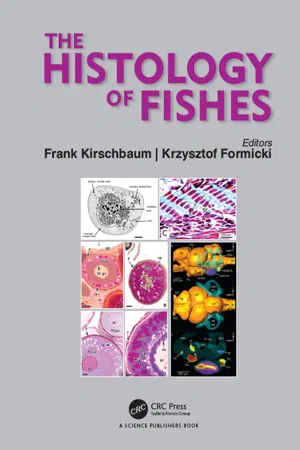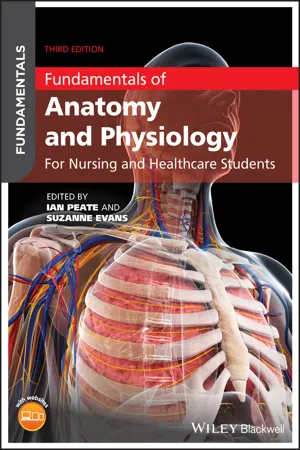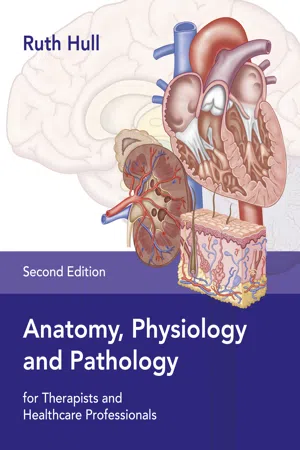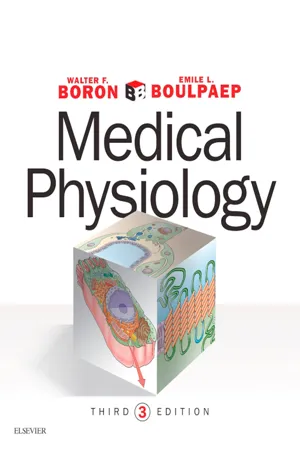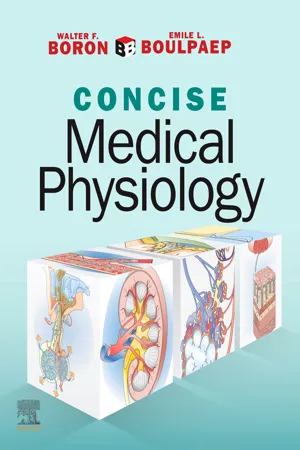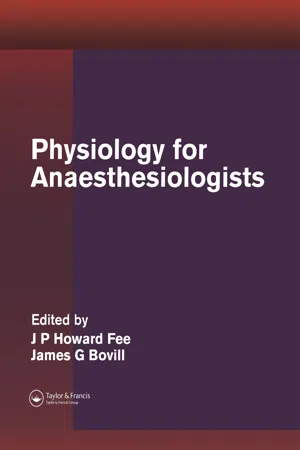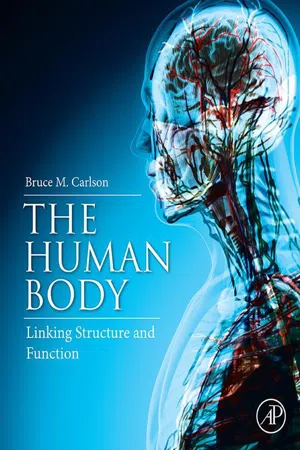Biological Sciences
Endocrine System
The endocrine system is a network of glands that produce and release hormones to regulate various bodily functions, such as metabolism, growth, and reproduction. These hormones are transported through the bloodstream to target organs and tissues, where they help maintain homeostasis and coordinate the body's responses to internal and external stimuli.
Written by Perlego with AI-assistance
Related key terms
10 Key excerpts on "Endocrine System"
- eBook - ePub
- Krzysztof Formicki, Frank Kirschbaum, Krzysztof Formicki, Frank Kirschbaum(Authors)
- 2019(Publication Date)
- CRC Press(Publisher)
18Endocrine System
Werner Kloas1 and Frank Kirschbaum2 *
Endocrine Systems regulate body homeostasis by hormones affecting reproduction, metabolism, osmomineral regulation, stress, development (metamorphosis), color change, and behavior. Hormones are chemical messengers, synthesized in specific cells and released internally to cause physiological reactions in distant cells or organs at very low concentrations. The biological actions act due to the principle of key and key hole by specific receptors of target cells binding the hormone to elicit a cellular response by activation or inactivation of signal transduction pathways ranging from short lasting metabolic to long lasting genomic responses. Lipophilic hormones (steroids, thyroid hormones) act mainly via genomic effects whereas hydrophilic ones (catecholamines, peptide hormones) affect target cells via membrane bound receptors affecting physiological cellular activities. The number of new hormones detected, especially concerning peptide hormones, is exponentially increasing because of the application of modern molecular genetic techniques. Their functions, however, are mostly unknown.The Endocrine System is organized, together with the central nervous system, in a hierarchical manner. The highest hierarchic level is the hypothalamus triggering the pituitary by releasing (or inhibiting) hormones to stimulate the classical endocrine glands: thyroid gland, ovary and testis, adrenal gland, or the liver being a source of hormones (insulin like growth factor-I) as well as a target organ. The classical endocrine glands secrete their hormones into the blood circulation to affect their target organs. At each hierarchic level like the hypothalamus, the pituitary, the endocrine glands and the target organs further endogenous and exogenous factors can influence their regulation.In this chapter, we restrict our description to the Endocrine System of teleosts. They possess, apart from the classical endocrine organs of higher vertebrates, additional organs like the corpuscles of Stannius, the urophysis, the ultimobranchial body, and the pseudobranch. - eBook - ePub
- Patricia Barnes-Svarney, Thomas E. Svarney(Authors)
- 2016(Publication Date)
- Visible Ink Press(Publisher)
INTRODUCTION What are the functions of the Endocrine System?The Endocrine System, together with the nervous system, controls and coordinates the functions of all of the human body systems. The Endocrine System helps to maintain homeostasis and metabolic functions, allows the body to react to stress, and regulates growth and development, including sexual development.What are the similarities between the nervous system and the Endocrine System?Both the nervous system and Endocrine System are devoted to maintaining homeostasis by coordinating and regulating the activities of other cells, tissues, organs, and systems. Both systems are regulated by negative feedback mechanisms. Chemical messengers are important in both systems, although their method of transmission and release differs in the two systems.How does the Endocrine System differ from the nervous system?Both the endocrine and nervous systems are regulatory systems that permit communication between cells, tissues, and organs. A major difference between the Endocrine System and nervous system is the rate of response to a stimulus. In general, the nervous system responds to a stimulus very rapidly, often within a few milliseconds, while it may take the Endocrine System seconds and sometimes hours or even days to offer a response. Furthermore, the chemical signals released by the nervous system typically act over very short distances (a synapse), while hormones in the Endocrine System are generally carried by the blood to target organs. Finally, the effects of the nervous system generally last only a brief amount of time, while those of the Endocrine System are longer lasting. Examples of endocrine control are growth and reproductive ability.The Endocrine System. What are the organs of the Endocrine System?The Endocrine System consists of glands and other hormone-producing tissues. Glands are specialized cells that secrete hormones into the interstitial fluid. Hormones are then transported to the capillaries and circulated via the blood. The major endocrine glands are the pituitary, thyroid, parathyroid, pineal, and adrenal The Endocrine System. glands. Other hormone-secreting organs are the central nervous system (hypothalamus), kidneys, heart, pancreas, thymus, ovaries, and testes. Some organs, such as the pancreas, secrete hormones as an endocrine function but have other functions also. - eBook - ePub
Fundamentals of Anatomy and Physiology
For Nursing and Healthcare Students
- Ian Peate, Suzanne Evans, Ian Peate, Suzanne Evans(Authors)
- 2020(Publication Date)
- Wiley-Blackwell(Publisher)
The nervous system reacts rapidly to stimuli and effects its changes over a period of seconds or minutes; thus, it is involved in the immediate and short‐term maintenance of homeostasis. Owing to its rapid onset of action, the nervous system is responsible for the control of rapid bodily processes such as breathing and movement. The Endocrine System is often responsible for the regulation of longer term processes. The major functions it coordinates are- homeostasis – maintains the internal body environment;
- storage and utilisation of energy substrates (carbohydrates, proteins and fats);
- regulation of growth and reproduction;
- control of the body’s responses to external stimuli (particularly stress).
The Endocrine System is made up of a collection of small organs that are scattered throughout the body, each of which releases hormones into the blood supply (‘endo’ = within, ‘crine’ = to secrete). These hormone‐releasing organs can be split into three main categories (Jenkins and Tortora, 2013 ).- Endocrine glands – organs whose only function is the production and release of hormones. These include:
- pituitary gland
- thyroid gland
- parathyroid gland
- adrenal gland.
- Organs that are not pure glands (as they have other functions as well as the production of hormones) but contain relatively large areas of hormone‐producing tissue. These include:
- hypothalamus
- pancreas.
- Other tissues and organs that also produce hormones – areas of hormone‐producing cells are found in the wall of the small intestine and the stomach.
There are no cell types, organs or processes that are not influenced by the Endocrine System in some way and while there are many hormones that we know of there are probably many more that are yet to be discovered.The Endocrine Organs
Figure 16.1 shows the endocrine organs and their position within the body. Each of these organs will typically have a rich blood supply delivered by numerous blood vessels. The hormone‐producing cells within the organ are arranged into branching networks around this supply. This arrangement of blood vessels and hormone‐producing cells ensures that hormones enter the bloodstream rapidly and are then transported throughout the body to the target cells (see Figure 16.2 - eBook - ePub
Fundamentals of Children and Young People's Anatomy and Physiology
A Textbook for Nursing and Healthcare Students
- Ian Peate, Elizabeth Gormley-Fleming, Ian Peate, Elizabeth Gormley-Fleming(Authors)
- 2021(Publication Date)
- Wiley-Blackwell(Publisher)
Figure 11.1 .The Endocrine System.Figure 11.1Source: Illustration from Anatomy & Physiology, Connexions Web site. http://cnx.org/content/col11496/1.6/ , Jun 19, 2013. Licensed under Attribution 3.0 Unported (CC BY 3.0).The integrity and health of the Endocrine System are essential to maintaining healthy body weight, growth and both physical and emotional development. The Endocrine System significantly affects children and young people who are experiencing a high rate of development, and different parts of this system play a role as ageing occurs.Hormones are major systemic regulators of homeostatic functions (Neumann et al., 2019). Their effects are varied and many which can be categorised into four broad areas as relevant to the developing child:- They play a role in the sequential integration of growth and development.
- They contribute to basic processes of reproduction, starting as early as gamete formation, fertilisation, stability of the growing fetus, labour and the subsequent adaptation to extrauterine life.
- They help to control the internal environment throughout life by regulation and homeostasis of many physiological functions.
- They respond to changes in environmental conditions to assist the body to cope with emergency demands, such as stress, trauma, dehydration and temperature imbalances (Greenstein and Wood, 2011; Waugh and Grant, 2018).
Physiology of the Endocrine System
The Endocrine System works alongside the nervous system to control many vital functions of the body. The nervous system provides a very fast and narrowly targeted system to act on specific glands and muscles throughout the body. The Endocrine System, on the other hand, is much slower acting, but has very widespread, long‐lasting and powerful effects. Hormones are distributed by glands through the bloodstream to the entire body, affecting any cell with a receptor for a particular hormone (Molina, 2018). Whilst the two systems are different in these specific ways, it is important to remember how they also work together to affect cells in several organs or tissues throughout the entire body, leading to many potent and diverse responses. Overall, the two systems work together closely to coordinate their activities in an integrated way. When a gland in the Endocrine System releases a hormone, it travels via the bloodstream to a target area where it exerts its effect. Hormones are designed to interact with a specific part of the body, so when the hormone arrives at this organ or tissue, a particular action takes place (Williams and Hopper, 2019). - eBook - ePub
- Ruth Hull(Author)
- 2021(Publication Date)
- Lotus Publishing(Publisher)
7 The Endocrine System IntroductionWhy is it that some people are exceptionally tall while others are small? Or some people can have children while others can’t? What is it that controls such processes in our bodies? It is the same system that controls our blood pressure, immune system, metabolism and even our response to danger. It is the Endocrine System.The study of the glands and hormones of the Endocrine System is endocrinology . In this chapter you will learn about the Endocrine System and discover how it works together with your nervous system to control all the other systems of your body.Student objectives By the end of this chapter you will be able to:• Describe the functions of the Endocrine System• Describe the organisation of the Endocrine System• Explain what a hormone is and how it works• Identify the differences between the nervous and Endocrine Systems• Describe the endocrine glands and the hormones they produce• Identify the common pathologies of the Endocrine System.Did you know?Before looking at the functions of the Endocrine System, it helps to understand exactly what endocrine glands and hormones are. There are two types of glands in the body: exocrine and endocrine.The endocrine glands are not the only tissues in the body that secrete hormones. The kidneys, stomach, liver, small intestine, skin, heart and placenta also contain cells that secrete small amounts of hormones.• Exocrine glands: These secrete substances into ducts that carry the substances into body cavities or to the outer surface of the body. Examples of exocrine glands include sudoriferous (sweat), sebaceous (oil), mucous and digestive glands.• Endocrine glands: These secrete substances into the extracellular space around their cells. The secretions then diffuse into blood capillaries and are transported by the blood to target cells located throughout the body. Substances secreted by endocrine glands are called hormones - eBook - ePub
Teen Health from Head to Toe
Exploring Issues and Risks
- Mary O'Reilly(Author)
- 2020(Publication Date)
- Greenwood(Publisher)
SEVEN Endocrine System OVERVIEWThe Endocrine System consists of specific organs that produce chemical messengers, called hormones, which are released directly into the blood stream. Hormones travel in the blood until they encounter a chemical receptor with which they can combine. The hormone and its receptor are very much like a key and a lock. Each hormone can only combine with receptors specific for that hormone. The goal of the Endocrine System is to maintain homeostasis, which is a steady internal equilibrium optimal for health.The classical idea of a hormone is that it acts in areas of the body distant from where it is produced. The organs of the classical Endocrine System include: •the pituitary gland •adrenals •thyroid •reproductive organs (ovaries, testes, and mammary glands) •pancreas •parathyroid •pineal glandThe pituitary gland is called the master gland because it produces hormones that control growth, metabolism, water and salt (electrolyte) balance, stress, and reproduction. It is attached to the brain and located close to the geometric center of the head. The larger part the pituitary gland (anterior pituitary) produces (1) adrenocorticotropic hormone (ACTH), which acts on the adrenal gland; (2) thyroid-stimulating hormone (TSH), which acts on the thyroid gland; and (3) growth hormone (GH or somatotropin), which affects all cells but acts primarily on bone, muscle, and liver. The anterior pituitary gland also produces three sex hormones—follicle-stimulating hormone (FSH), luteinizing hormone (LH), and prolactin, which act on the reproductive system and will be discussed further in the chapter on reproduction. The smaller (posterior) part of the pituitary gland produces anti-diuretic hormone (ADH), also called vasopressin, and oxytocin.The pituitary gland itself is controlled by hormones made in a part of the brain called the hypothalamus, which is adjacent to the pituitary. The hypothalamus makes hormones that travel in special blood vessels to the pituitary. The hormones from the hypothalamus either stimulate or inhibit release of pituitary hormones. Both ACTH and TSH are released from the pituitary in response to their respective stimulating hormones from the hypothalamus. GH is uniquely regulated by both a stimulatory hormone and an inhibitory hormone (somatostatin). - eBook - ePub
Medical Physiology E-Book
Medical Physiology E-Book
- Walter F. Boron, Emile L. Boulpaep(Authors)
- 2016(Publication Date)
- Elsevier(Publisher)
Section VIII The Endocrine SystemOutlineChapter 47 Organization of Endocrine Control Chapter 48 Endocrine Regulation of Growth and Body Mass Chapter 49 The Thyroid Gland Chapter 50 The Adrenal Gland Chapter 51 The Endocrine Pancreas Chapter 52 The Parathyroid Glands and Vitamin DPassage contains an image
Chapter 47With the development of multicellular organisms that have specialized tissues and organs, two major systems evolved to communicate and coordinate body functions:Organization of Endocrine Control
Eugene J. Barrett1. The nervous system integrates tissue functions by a network of cells and cell processes that constitute the nervous system and all subdivisions, as discussed in Chapters 10 through 16 .2. The Endocrine System integrates organ function via chemicals that are secreted from endocrine tissues or “glands” into the extracellular fluid. These chemicals, called hormones, are then carried through the blood to distant target tissues where they are recognized by specific high-affinity receptors. As discussed in Chapter 3 , these receptors may be located either on the surface of the target tissue, within the cytosol, or in the target cell's nucleus. These receptor molecules allow the target cell to recognize a unique hormonal signal from among the numerous chemicals that are carried through the blood and bathe the body's tissues. The accuracy and sensitivity of this recognition are remarkable in view of the very low concentration (10−9 to 10−12 M) at which many hormones circulate.Once a hormone is recognized by its target tissue or tissues, it can exert its biological action by a process known as signal transduction (see Chapter 3 - eBook - ePub
Boron & Boulpaep Concise Medical Physiology E-Book
Boron & Boulpaep Concise Medical Physiology E-Book
- Walter F. Boron, Emile L. Boulpaep(Authors)
- 2020(Publication Date)
- Elsevier(Publisher)
Section VIII The Endocrine SystemOutlineChapter 47. Organization of Endocrine ControlChapter 48. Endocrine Regulation of Growth and Body MassChapter 49. The Thyroid GlandChapter 50. The Adrenal GlandChapter 51. The Endocrine PancreasChapter 52. The Parathyroid Glands and Vitamin DPassage contains an image
Chapter 47: Organization of Endocrine Control
Eugene J. BarrettMulticellular organisms evolved two major systems to communicate and to coordinate body functions:- 1. The nervous system integrates tissue functions by a network of cells and cell processes that constitute the nervous system and all subdivisions, as discussed in Chapters 10 through 16 .
-
2. The Endocrine System integrates organ function via chemicals that are secreted from endocrine tissues or “glands” into the extracellular fluid. These chemicals, called hormones, are carried through the blood to distant target tissues, where they are recognized by specific high-affinity receptors. As discussed in Chapter 3 , these receptors may be located on the surface of the target tissue, within the cytosol, or in the target cell’s nucleus. These receptor molecules allow the target cell to recognize a unique hormonal signal from among the numerous chemicals that are carried through the blood and bathe the body’s tissues. The accuracy and sensitivity of this recognition are remarkable in view of the very low concentration (10− 9to 10− 12M) at which many hormones circulate.
Once a hormone is recognized by its target tissue or tissues, it can exert its biological action by a process known as signal transduction (see Chapter 3 - eBook - ePub
- J.P. Howard Fee, James G. Bovill, J.P. Howard Fee, James G. Bovill(Authors)
- 2004(Publication Date)
- CRC Press(Publisher)
7 The Endocrine System
William FM WallaceDEFINITION AND SCOPE
Endocrine glands are distinguished from exocrine glands because they secrete within the body (endo) rather than out of the body (exo). The hormones that they secrete pass via the circulation to produce an effect by acting on target organs. This chapter considers the hormones most relevant to anaesthetic practice: insulin, thyroid hormones, hormones of the adrenal cortex and medulla, and parathormone. Within this framework, other hormones and influences are also considered, since the body’s responses are always complex. Thus glucose metabolism during intensive care is influenced by such hormones as insulin, glucagon, cortisol, and thyroxine, as well as autonomic nerves and local factors in damaged tissues.The next part of the chapter looks at the question, ‘Why an Endocrine System?’, and at the end of the chapter the stress response is examined to illustrate the complex interactions of the endocrine, nervous, and cytokine systems. A notable example of such interactions is given by the sympathetic activating response, evoked in ‘fight and flight’ situations. Here the sympathetic nerves produce skin pallor, sweating, tremor, and tachycardia. At the same time, preganglionic sympathetic neurones activate the adrenal medulla to release large amounts of adrenaline and smaller amounts of noradrenaline and related hormones of the catecholamine family. Finally, if the response is prolonged, noradrenaline released as a neurotransmitter accumulates in the circulation to act together with the hormonal noradrenaline from the adrenal medulla—a neurotransmitter has become a hormone.In recent decades, many other chemicals have been discovered, that add to the transmitter/ hormonal cocktail in the circulation. Some are released and act on the releasing cell itself (autocrines) or on nearby cells (paracrines). Others are released from individual cells, particularly white blood cells, act locally and also enter the circulation to act in many respects like hormones—the cytokines. - eBook - ePub
The Human Body
Linking Structure and Function
- Bruce M. Carlson, Bruce M. Carlson(Authors)
- 2018(Publication Date)
- Academic Press(Publisher)
Chapter 9The Endocrine System
Abstract
Hormones act on cells by binding to surface or intracellular receptors and then eliciting a specific response from these cells. Much of the Endocrine System is organized in a hierarchical fashion, with releasing hormones of the hypothalamus controlling secretions of the adenohypophysis, and stimulating hormones of the adenohypophysis controlling release of hormones from the thyroid, adrenal cortex, and gonads. The neurohypophysis is a neurosecretory organ. At all levels, secretions are controlled by inhibitory feedback loops from downstream endocrine organs. Signals from higher brain centers can exert a profound effect on endocrine secretions. Female reproductive cycles, in particular, are tightly controlled by hormones produced by both the adenohypophysis and the ovaries. In turn, steroid hormones produced in the ovaries modulate secretions of both the hypothalamus and pituitary.Keywords
Endocrine glands; evolution; paracrine and autocrine secretion; steroid hormones; protein hormones; hypothalamus; pituitary gland; adenohypophysis; neurohypophysis; adrenal cortex; adrenal medulla; thyroid gland; parathyroid gland; ovary; testis; hypothalamic–pituitary–adrenal axis; releasing hormones; islets of Langerhans; reproductive cyclesThe more we learn about the human body, the more we realize how interconnected and how integrated are most bodily functions. Obvious examples of whole-body interconnectedness are the nervous and circulatory systems because of their structural organization and distribution. Other interconnections are more subtle. The connective tissue linkages throughout the body are very structural, but their importance in the overall functioning of the body has only recently been generally recognized. Another set of linkages—the hormones produced by the endocrine glands—is principally chemical, but through the mediation of both the circulatory and nervous systems, endocrine secretions reach almost every cell of the body.
Index pages curate the most relevant extracts from our library of academic textbooks. They’ve been created using an in-house natural language model (NLM), each adding context and meaning to key research topics.
